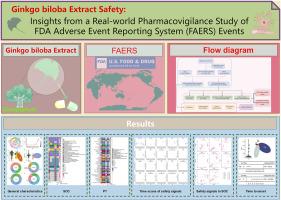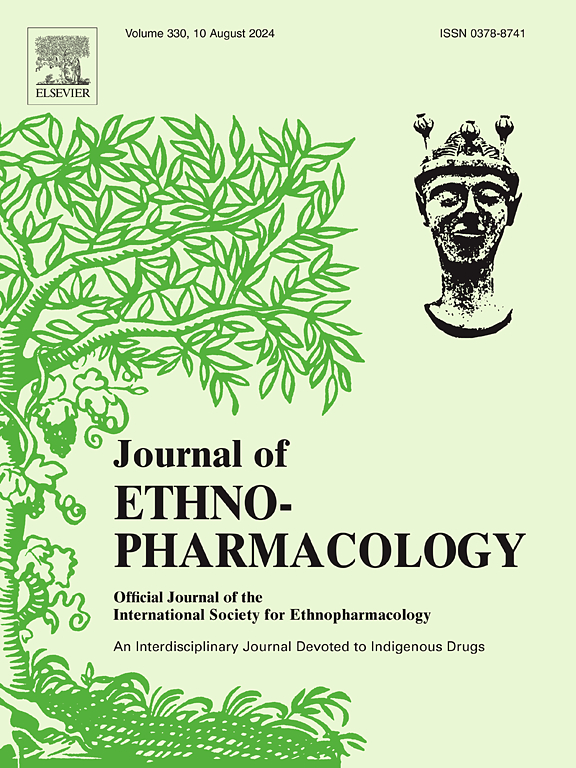Ginkgo biloba extract safety: Insights from a real-world pharmacovigilance study of FDA adverse event reporting system (FAERS) events
IF 4.8
2区 医学
Q1 CHEMISTRY, MEDICINAL
引用次数: 0
Abstract
Ethnopharmacological relevance
A traditional Chinese medicine extracted from the Ginkgophyta, Ginkgo biloba is commonly used to treat cardiac cerebral disease all over the world. Limited data exist regarding adverse drug reactions associated with Ginkgo biloba extract post-marketing.
Aim of the study
Currently, the drug safety profile of Ginkgo biloba extract is assessed using a substantial volume of case safety reports within the FDA Adverse Event Reporting System (FAERS) database.
Materials and methods
The study collected adverse events (AEs) data associated with Ginkgo biloba extract as the primary suspected drug from 2004 to 2023 from the FAERS database. A standardized mapping analysis of System Organ Class (SOC) and preferred term (PT) was conducted. Utilizing reporting odds ratio (ROR), proportional reporting ratio (PRR), information component (IC), and empirical Bayes geometric mean (EBGM), significant disproportionate measurement signals of adverse drug reactions (ADR) were identified and high-intensity signals were analyzed.
Results
700 reports of adverse events related to Ginkgo biloba extract were found in the FAERS database, affecting 23 organ systems. 88 significant mismatches were identified using four algorithms, leading to unexpected major adverse events like amaurosis fugax, fractional exhaled nitric oxide created, and obstructive sleep apnoea syndrome. The study observed a median onset time of AE associated with Ginkgo biloba extract at 7 days (interquartile interval [IQR] 0–109 days), with the majority of AE manifesting within the initial 7 days of drug treatment initiation. This investigation identified a noteworthy AE signal for Ginkgo biloba extract, underscoring the importance of clinical surveillance and risk assessment in its use.
Conclusions
In clinical practice, this study provides a deeper and broader understanding of suspected adverse reactions associated with Ginkgo biloba extract.

银杏叶提取物的安全性:从 FDA 不良事件报告系统 (FAERS) 事件的真实世界药物警戒研究中获得的启示。
民族药理学意义:银杏叶是从银杏科植物中提取的一种传统中药,在世界各地常用于治疗心脑疾病。有关银杏叶提取物上市后药物不良反应的数据有限:目前,银杏叶提取物的药物安全性概况是通过FDA不良事件报告系统(FAERS)数据库中的大量病例安全性报告进行评估的:该研究从 FAERS 数据库中收集了 2004 年至 2023 年期间以银杏叶提取物为主要可疑药物的相关不良事件(AEs)数据。对系统器官分类(SOC)和首选术语(PT)进行了标准化映射分析。利用报告几率比(ROR)、比例报告比(PRR)、信息成分(IC)和经验贝叶斯几何平均数(EBGM),确定了药物不良反应(ADR)的显著不成比例测量信号,并对高强度信号进行了分析:结果:在 FAERS 数据库中发现了 700 份与银杏叶提取物有关的不良事件报告,涉及 23 个器官系统。使用四种算法识别出88个重大不匹配,导致了一些意想不到的重大不良事件,如眼花、呼出一氧化氮分数生成和阻塞性睡眠呼吸暂停综合征。研究观察到,银杏叶提取物相关不良反应的中位发病时间为 7 天(四分位间距 [IQR] 0-109 天),大多数不良反应在开始用药的最初 7 天内出现。这项调查发现了银杏叶提取物值得注意的AE信号,强调了使用银杏叶提取物时临床监测和风险评估的重要性:在临床实践中,这项研究让人们对银杏叶提取物的可疑不良反应有了更深入、更广泛的了解。
本文章由计算机程序翻译,如有差异,请以英文原文为准。
求助全文
约1分钟内获得全文
求助全文
来源期刊

Journal of ethnopharmacology
医学-全科医学与补充医学
CiteScore
10.30
自引率
5.60%
发文量
967
审稿时长
77 days
期刊介绍:
The Journal of Ethnopharmacology is dedicated to the exchange of information and understandings about people''s use of plants, fungi, animals, microorganisms and minerals and their biological and pharmacological effects based on the principles established through international conventions. Early people confronted with illness and disease, discovered a wealth of useful therapeutic agents in the plant and animal kingdoms. The empirical knowledge of these medicinal substances and their toxic potential was passed on by oral tradition and sometimes recorded in herbals and other texts on materia medica. Many valuable drugs of today (e.g., atropine, ephedrine, tubocurarine, digoxin, reserpine) came into use through the study of indigenous remedies. Chemists continue to use plant-derived drugs (e.g., morphine, taxol, physostigmine, quinidine, emetine) as prototypes in their attempts to develop more effective and less toxic medicinals.
 求助内容:
求助内容: 应助结果提醒方式:
应助结果提醒方式:


